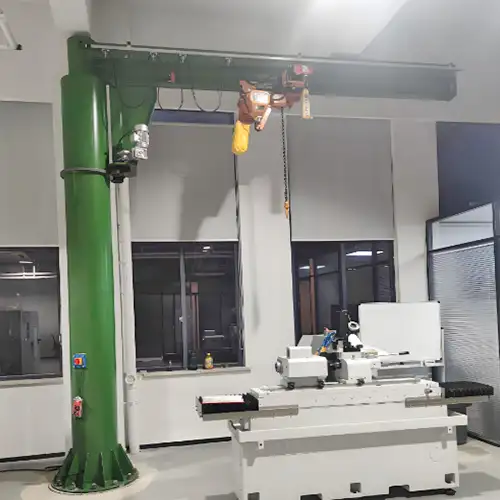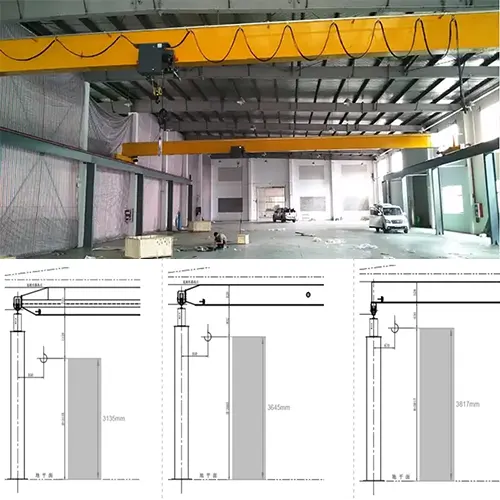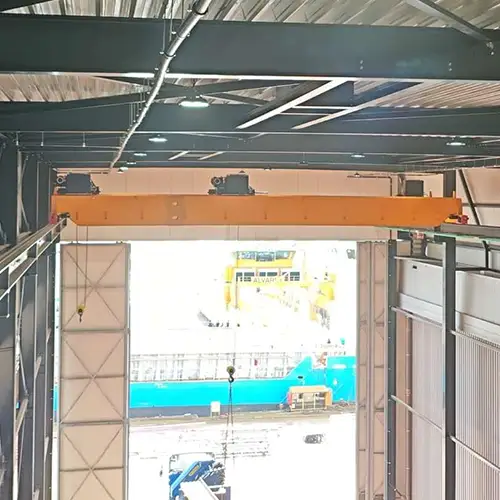Maximizing Space: How Pillar Mounted Jib Cranes Optimize Small Business Operations
Discover how pillar mounted jib cranes enhance space utilization, streamline operations, and boost efficiency for small businesses in various industries.
Category: Low Built Cranes & Hoists
Your Trusted Low Headroom Jib Crane Manufacturer & Supplier
Maximizing Space: How Pillar Mounted Jib Cranes Optimize Small Business Operations
Discover how pillar mounted jib cranes enhance space utilization, streamline operations, and boost efficiency for small businesses in various industries.
Pillar Mounted Jib Cranes
Pillar mounted jib cranes are versatile lifting devices that consist of a horizontal arm (the jib) attached to a vertical post or pillar. These cranes allow for the smooth lifting and movement of materials and equipment within a designated area. The jib can pivot 360 degrees around the pillar, providing extensive coverage and accessibility. Designed for efficiency, pillar mounted jib cranes can handle various loads, making them suitable for numerous applications in small businesses.
Importance of Space Utilization in Small Businesses
For small businesses, effective space utilization is crucial for optimizing productivity and maximizing operational efficiency. Limited floor space often poses challenges when it comes to managing inventory, handling materials, and organizing workstations. Efficiently using available space can lead to better workflow, reduced clutter, and improved safety. In this context, pillar mounted jib cranes serve as a practical solution, allowing businesses to make the most of their compact environments without sacrificing functionality.
Overview of the Benefits of Pillar Mounted Jib Cranes
Pillar mounted jib cranes offer several advantages for small business operations. First, their compact design enables them to fit into tight spaces, allowing for optimal placement in various work areas. This flexibility improves workflow by facilitating quick and easy access to materials and equipment. Additionally, these cranes enhance safety by reducing the risk of manual handling injuries, as they allow operators to lift and move heavy items with minimal effort. Furthermore, by streamlining operations and improving space utilization, pillar mounted jib cranes contribute to increased productivity and efficiency, ultimately supporting the growth and success of small businesses.
Pillar Mounted Jib Cranes
Design Features
Description of the Pillar-Mounted Structure
Pillar mounted jib cranes feature a robust and sturdy design, consisting of a vertical pillar fixed to the ground, which supports a horizontal arm or jib. This arm extends outward and can pivot around the pillar, allowing for versatile movement across a wide range. The pillar is typically constructed from high-strength steel or other durable materials to ensure stability and safety during operation. The height and length of the jib can vary based on specific business needs, providing flexibility in lifting and moving loads within different work environments. This design not only maximizes lifting capacity but also minimizes the footprint, making it ideal for confined spaces.
Capacity Options (e.g., 2T, 3T, 5T, upto 16 Ton )
Pillar mounted jib cranes are available in various load capacities to cater to the needs of small businesses. Common options include 2-ton (2T), 3-ton (3T), and 5-ton (5T) model, and heavy duty type 10 ton up to 16 ton models. The capacity selection depends on the specific requirements of the operation, including the types of materials being handled and the weight of the loads. Choosing the right capacity is essential for ensuring safety and efficiency, as overloading a crane can lead to mechanical failure or accidents. Small business owners should evaluate their typical lifting needs to select a jib crane that optimally supports their operations without compromising safety.
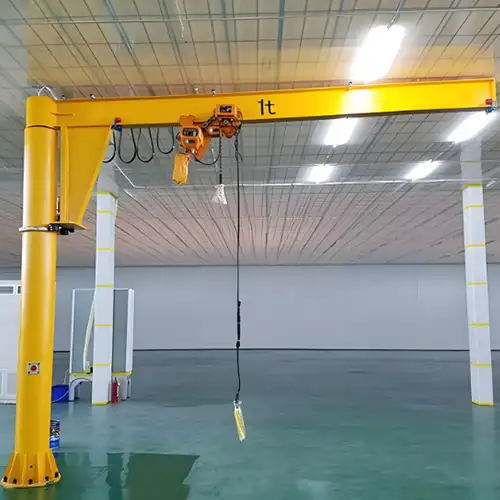
H beam pillar mounted jib crane with low headroom hoist for low built workshop and facility
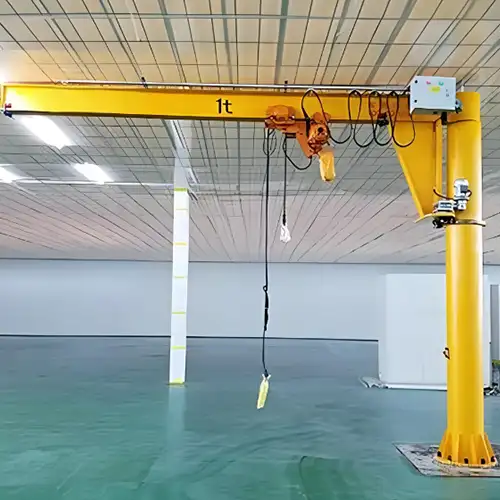
Electric motorized cantilever jib crane with low headroom design for sale
How They Operate
Functionality and Maneuverability
Pillar mounted jib cranes are designed for ease of use and excellent maneuverability. The jib can rotate 360 degrees around the pillar, allowing operators to access materials from multiple angles without repositioning the crane. This rotational ability enhances workflow by enabling quick and efficient lifting and placement of loads. Additionally, many models come with electric or manual hoists that can raise and lower materials smoothly, providing precise control over movements. This functionality reduces the time spent handling loads and improves overall productivity in small business settings.
Comparison to Other Lifting Solutions
When comparing pillar mounted jib cranes to other lifting solutions, such as overhead cranes or forklifts, several advantages become evident. Unlike overhead cranes, which require more extensive overhead infrastructure and can be cost-prohibitive, pillar mounted jib cranes have a relatively simple installation process and occupy less vertical space. They are also more cost-effective and can be installed in various locations without extensive modifications to the facility. Compared to forklifts, which require skilled operators and may not be suitable for tight spaces, pillar mounted jib cranes provide a safer and more efficient alternative for lifting and moving heavy materials. Their ease of use, low maintenance requirements, and ability to fit into compact work environments make them an ideal choice for small businesses looking to enhance their material handling capabilities.
Space-Saving Solutions: How Pillar-Mounted Jib Cranes Optimize Limited Headroom Environments
In today's fast-paced industrial landscape, optimizing workspace efficiency is paramount. Facilities often face constraints due to limited ceiling height or cramped layouts, making it challenging to implement effective lifting solutions. Pillar-mounted jib cranes emerge as a practical answer to these challenges, providing a space-saving solution tailored for low headroom environments.
Compact Design and Footprint
Pillar-mounted jib cranes feature a streamlined design that minimizes their overall footprint. Unlike traditional overhead cranes, which require extensive structural supports and headroom, these cranes consist of a vertical pillar and a horizontal arm. This compact configuration allows for installation in tight corners, against walls, or even under low ceilings, making them ideal for workshops with spatial limitations. By occupying less floor space, these cranes free up valuable room for other operational activities, enhancing overall productivity.
Pillar-mounted jib cranes are an innovative solution designed for environments with spatial limitations. Their compact design offers numerous advantages that optimize workspace efficiency. Below, we explore the key features of their streamlined design and minimal footprint.
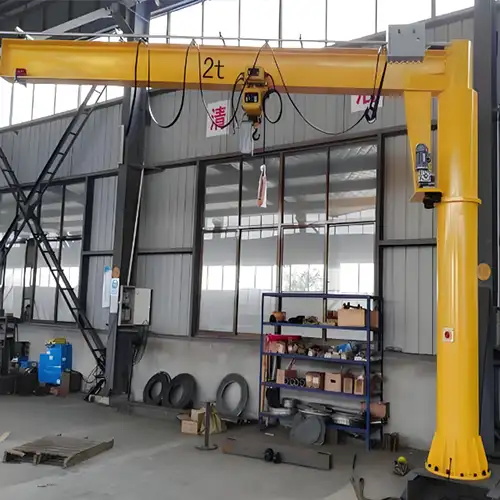
What Makes Pillar-Mounted Jib Cranes Compact?
- Simple Construction
Pillar-mounted jib cranes consist of a vertical support pillar (mast) and a horizontal arm (boom) that extends from the pillar. This simple configuration eliminates the need for extensive structural supports, unlike traditional overhead cranes that require additional overhead clearance. - Minimal Structural Modifications
Traditional cranes often demand significant alterations to a building's structure, such as reinforced beams and increased headroom. In contrast, pillar-mounted jib cranes can be installed with minimal modifications, leading to reduced installation costs and time.
Where Can These Cranes Be Installed?
- Ideal for Confined Spaces
One of the standout features of these cranes is their ability to fit into confined areas. They can be placed in tight corners, along walls, or beneath low ceilings, making them perfect for workshops or warehouses with limited space. - Strategic Placement
Their compact design allows for placement close to assembly lines, machine tools, or loading docks. This strategic positioning enables targeted lifting capabilities without requiring excessive surrounding space.
How Do They Enhance Workflow?
- Efficient Use of Floor Space
By taking up less floor area than traditional cranes, pillar-mounted jib cranes allow businesses to maximize their operational footprint. This efficient use of space frees up room for other activities, enhancing overall productivity. - Improved Accessibility
The smaller footprint enables cranes to be located closer to workstations, facilitating quicker access to materials. This proximity minimizes downtime, ensuring that workers can efficiently handle tasks.
What Are the Versatility and Adaptability Benefits?
- Flexible Installation Options
Pillar-mounted jib cranes can be mounted on various surfaces, such as concrete floors, existing structural columns, or walls. This adaptability allows them to fit seamlessly into different facility layouts. - Customization for Layout Design
With their compact nature, these cranes can be tailored to suit various operational needs, making them versatile in diverse industrial settings.
How Do They Contribute to a Reduced Operational Footprint?
- Streamlined Operations
Pillar-mounted jib cranes help minimize the operational footprint of a facility. They facilitate more efficient workflows and reduce material movement, resulting in better organization and safety in the workspace. - Enhanced Safety
The reduction in congestion allows workers to move freely, minimizing the risk of accidents while ensuring that materials are handled efficiently.
Pillar-mounted jib cranes offer a compact design and minimal footprint, making them a valuable asset for businesses in limited space environments. Their ability to optimize floor space, reduce structural requirements, and enhance workflow efficiency positions them as a practical lifting solution in modern industrial settings.
Maximized Lifting Height
One of the significant advantages of pillar-mounted jib cranes is their ability to provide maximum lifting height while maintaining a low profile. The boom can be positioned closer to the floor, allowing for effective lifting without requiring excessive vertical clearance. This feature is particularly beneficial in environments where traditional cranes cannot operate due to headroom constraints. As a result, workers can efficiently handle materials, even in spaces that seem unsuitable for lifting operations.
Pillar-mounted jib cranes are engineered to excel in environments with headroom constraints. One of their standout features is the ability to maximize lifting height while maintaining a low profile. This capability is essential for efficient material handling in various industrial settings.
How Do Pillar-Mounted Jib Cranes Maximize Lifting Height?
- Low Boom Positioning
The design of pillar-mounted jib cranes allows their booms to be positioned closer to the floor. This low-profile design means that the boom can effectively lift materials without requiring extensive vertical clearance. Traditional cranes often necessitate significant overhead space, limiting their applicability in environments with low ceilings. - Optimal Use of Vertical Space
By maximizing lifting height, these cranes utilize the available vertical space more efficiently. In workshops or warehouses where headroom is limited, this feature enables operators to lift materials to their desired height without compromising safety or efficiency.
Why Is This Important in Limited Headroom Environments?
- Flexibility in Material Handling
In facilities with low ceilings, traditional overhead cranes may be impractical or even impossible to install. Pillar-mounted jib cranes provide a flexible solution, allowing for effective lifting and movement of materials in tight spaces. This flexibility is crucial for industries such as manufacturing, automotive, and warehousing, where material handling is frequent. - Enhanced Worker Efficiency
The ability to lift materials efficiently in constrained environments translates to improved worker productivity. Operators can quickly move items to their required locations without the delays that often accompany the use of larger, traditional cranes. This efficiency helps maintain a smooth workflow, even in challenging settings.
Key Benefits of Maximized Lifting Height
- Increased Operational Capability
With the ability to lift materials higher without requiring excessive overhead space, pillar-mounted jib cranes expand the operational capabilities of a facility. This expanded capability is vital for handling a diverse range of materials, from heavy machinery components to lighter inventory items. - Safety Considerations
Safety is a paramount concern in any lifting operation. The low-profile design of pillar-mounted jib cranes helps reduce the risk of accidents associated with overhead collisions. By minimizing the height requirement, operators can navigate tight spaces safely, ensuring a secure working environment for all personnel. - Cost-Effectiveness
Utilizing available vertical space efficiently can lead to significant cost savings. Facilities do not need to invest in structural modifications or additional overhead clearance to accommodate traditional cranes. Instead, businesses can implement pillar-mounted jib cranes, which offer a more economical lifting solution.
Pillar-mounted jib cranes provide a unique advantage in maximizing lifting height while maintaining a low profile. Their design allows for effective lifting in environments with limited headroom, enhancing operational efficiency and safety. By leveraging this capability, businesses can optimize their material handling processes, making pillar-mounted jib cranes an invaluable asset in modern industrial settings.
360-Degree Rotation for Versatile Operations
Pillar-mounted jib cranes are designed to offer full 360-degree rotation around their base. This rotational capability allows operators to access multiple workstations from a single installation point. In limited space environments, where moving equipment around can be cumbersome, this feature streamlines material handling processes. Operators can lift and move loads without needing to reposition the crane, significantly reducing travel time and improving workflow efficiency.
Pillar-mounted jib cranes are engineered with functionality and efficiency in mind, and one of their most impressive features is their ability to rotate a full 360 degrees around their base. This capability significantly enhances material handling operations, particularly in environments with spatial constraints.
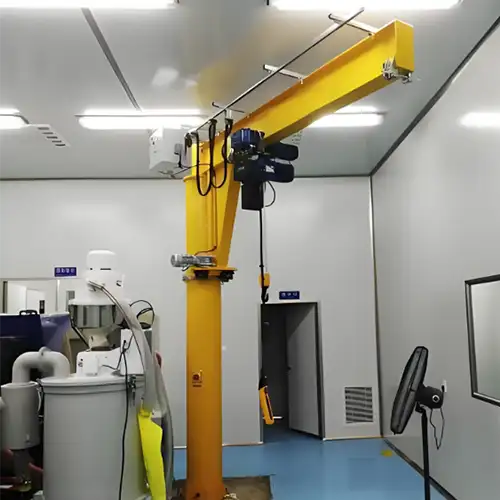
How Does 360-Degree Rotation Enhance Versatility?
- Access to Multiple Workstations
The full rotational capability allows operators to easily access various workstations without having to relocate the crane itself. This is particularly advantageous in workshops or warehouses where multiple tasks are performed in close proximity. Operators can efficiently handle materials from different points, reducing the need to move equipment or reposition the crane frequently. - Streamlined Material Handling
In limited space environments, moving equipment around can be cumbersome and time-consuming. The 360-degree rotation feature simplifies the material handling process, allowing operators to lift and move loads seamlessly across the workspace. This streamlined approach minimizes travel time and optimizes workflow efficiency.
Benefits of 360-Degree Rotation in Limited Space Environments
- Increased Operational Flexibility
The ability to rotate fully means that operators can maneuver loads in any direction without needing additional space for repositioning. This flexibility is crucial for facilities where floor space is limited and every inch counts. Operators can navigate around obstacles and efficiently move materials to their desired location without disruption. - Improved Safety
The design of pillar-mounted jib cranes allows for enhanced safety during operations. With the ability to rotate freely, operators can maintain better visibility of their work area, reducing the risk of accidents. The 360-degree rotation minimizes the need for awkward or unsafe lifting angles, promoting safer handling of materials. - Enhanced Productivity
The efficiency gained from 360-degree rotation translates directly into increased productivity. Operators can quickly adjust their position and lift loads without unnecessary delays, ensuring that tasks are completed swiftly and effectively. This heightened productivity is particularly beneficial in high-demand environments where time is of the essence. - Reduction in Equipment Costs
By enabling access to multiple workstations from a single installation point, pillar-mounted jib cranes can reduce the need for multiple cranes or lifting devices throughout a facility. This consolidation not only saves on equipment costs but also minimizes maintenance and operational expenses. - Optimized Use of Vertical Space
The rotational feature works in tandem with the crane's low-profile design, allowing for optimal use of vertical space. Operators can lift materials higher without needing to alter their position, maximizing the operational capabilities of the crane in environments with low ceilings.
Pillar-mounted jib cranes provide a remarkable advantage with their 360-degree rotation feature, enhancing versatility and operational efficiency. By enabling access to multiple workstations and streamlining material handling processes, these cranes are invaluable assets in limited space environments. Their ability to improve safety, increase productivity, and optimize the use of vertical space makes pillar-mounted jib cranes an essential choice for modern industrial operations.
Flexible Mounting Options
The versatility of pillar-mounted jib cranes extends to their installation options. These cranes can be mounted on various surfaces, including concrete floors, existing columns, or walls. This adaptability allows for optimal positioning based on the specific layout of the workshop. For facilities with limited headroom, customizing the mounting location ensures that the crane effectively meets the unique spatial constraints while still providing maximum functionality.
Pillar-mounted jib cranes are renowned for their adaptability, particularly when it comes to installation options. Their flexible mounting capabilities make them an excellent choice for various industrial settings, especially in workshops with unique spatial constraints.
How Do Flexible Mounting Options Enhance Versatility?
- Multiple Surface Mounting Options
Pillar-mounted jib cranes can be installed on various surfaces, including:- Concrete Floors: The most common mounting option, providing a stable base for lifting operations.
- Existing Columns: Utilizing existing structural elements helps save space and reduces installation costs.
- Walls: Mounting on walls is particularly beneficial in narrow aisles or tight areas, optimizing floor space and enhancing accessibility.
- Customizable Positioning
The adaptability of these cranes allows for optimal positioning based on the specific layout of the workshop. Operators can strategically place the crane to maximize its reach and efficiency, ensuring that it meets the unique demands of the work environment.
Benefits of Flexible Mounting Options in Limited Headroom Environments
- Maximizing Available Space
In facilities where headroom is limited, customizing the mounting location is crucial. Pillar-mounted jib cranes can be positioned in a way that allows them to operate effectively without interfering with overhead obstructions, such as ductwork or beams. This maximization of available space enables businesses to use their facilities more efficiently. - Enhanced Accessibility
The ability to mount cranes in various locations allows operators to place them closer to workstations, machinery, or storage areas. This proximity enhances accessibility, reducing the distance workers need to move materials, which can significantly improve workflow efficiency. - Quick and Easy Installation
Flexible mounting options facilitate quick and straightforward installation. Depending on the specific requirements, cranes can be easily mounted on-site, minimizing downtime and disruption to ongoing operations. - Adaptation to Changing Needs
As operational needs evolve, the flexibility of pillar-mounted jib cranes allows for easy relocation or repositioning. Businesses can adapt their lifting solutions to accommodate changes in production processes, workflows, or facility layouts without incurring significant costs. - Improved Safety and Compliance
Proper placement of pillar-mounted jib cranes reduces hazards associated with overcrowded workspaces. By strategically positioning cranes away from pedestrian paths and ensuring compliance with safety regulations, businesses can create a safer working environment. - Cost-Effectiveness
Utilizing existing structural elements or optimizing installation locations reduces the need for additional structural modifications. This cost-effectiveness is particularly beneficial for companies looking to enhance their lifting capabilities without incurring excessive expenses.
The flexible mounting options of pillar-mounted jib cranes significantly enhance their versatility, making them an ideal choice for a variety of industrial applications. By allowing for installation on various surfaces and enabling customizable positioning, these cranes effectively meet the unique spatial constraints of limited headroom environments. Their adaptability not only maximizes available space and improves accessibility but also contributes to increased safety and cost-effectiveness, making pillar-mounted jib cranes a valuable asset in any workshop setting.
Safe and Stable Operations
Safety is a critical consideration in any lifting operation. Pillar-mounted jib cranes are engineered for stability, with secure anchoring to the floor or a structural support. This stability is essential in low headroom environments, where the risk of collisions or tipping can be heightened. The low center of gravity design enhances safety, ensuring that loads can be lifted and moved confidently, without compromising the safety of workers or equipment.
Safety is paramount in any lifting operation, and pillar-mounted jib cranes are designed with this principle at the forefront. Their engineering emphasizes stability and secure anchoring, making them a reliable choice, especially in low headroom environments where the risks of collisions or tipping may be heightened.
Key Features Enhancing Safety and Stability
- Secure Anchoring Systems
Pillar-mounted jib cranes are anchored firmly to the floor or existing structural supports. This secure anchoring is critical for maintaining stability during lifting operations. The robustness of the anchoring system helps prevent shifting or movement of the crane while in use, ensuring that loads can be lifted safely. - Low Center of Gravity Design
The design of pillar-mounted jib cranes features a low center of gravity, which significantly enhances their stability. This design minimizes the risk of tipping or swaying during operations, allowing operators to lift and move loads confidently. A low center of gravity is especially beneficial in limited headroom environments, where overhead obstacles increase the potential for accidents.
Benefits of Safe and Stable Operations in Limited Headroom Environments
- Reduced Risk of Accidents
The stability provided by secure anchoring and a low center of gravity reduces the likelihood of accidents associated with lifting operations. By minimizing swaying and tipping risks, these cranes help create a safer working environment for operators and nearby personnel. - Enhanced Worker Confidence
When operators feel confident in the stability of their equipment, they can focus on their tasks without distractions or concerns about safety. This enhanced confidence leads to more efficient and effective material handling operations. - Protection of Equipment
Stable operations not only safeguard workers but also protect valuable equipment from damage. By preventing collisions or unexpected movements, pillar-mounted jib cranes help ensure that materials and machinery are handled carefully, reducing repair and replacement costs. - Compliance with Safety Regulations
The robust design and safety features of pillar-mounted jib cranes assist businesses in complying with industry safety regulations. Adhering to these regulations is crucial for maintaining a safe workplace and avoiding potential legal liabilities. - Adaptability to Various Work Environments
The stability of pillar-mounted jib cranes allows them to be used effectively in diverse environments, from manufacturing facilities to warehouses. This adaptability makes them a versatile choice for businesses looking to enhance their material handling capabilities.
Pillar-mounted jib cranes are engineered for safe and stable operations, making them an ideal choice for lifting in various environments, especially those with low headroom. Their secure anchoring systems and low center of gravity design ensure stability during operations, significantly reducing the risks associated with material handling. By prioritizing safety, these cranes enhance worker confidence, protect equipment, and help businesses comply with safety regulations, making them an invaluable asset in any industrial setting.
Cost-Effective Space Optimization
Implementing pillar-mounted jib cranes in low headroom environments can be a cost-effective solution. Compared to larger cranes that require extensive installation and structural modifications, these cranes typically involve lower installation costs. Their compact design means less disruption to existing workflows and less need for significant alterations to the facility. As a result, businesses can enhance their operational efficiency without incurring prohibitive expenses.
In today's competitive industrial landscape, cost-effectiveness is a crucial consideration for businesses looking to enhance their operational capabilities. Pillar-mounted jib cranes offer a practical solution for optimizing space in low headroom environments, delivering significant benefits while minimizing costs associated with installation and facility modifications.
Key Factors Contributing to Cost-Effective Space Optimization
- Lower Installation Costs
Pillar-mounted jib cranes typically involve lower installation costs compared to larger overhead cranes. Their streamlined design requires less extensive structural modifications and can often be installed more quickly, reducing labor and material expenses. This affordability makes them an attractive option for businesses looking to improve their lifting capabilities without large capital investments. - Minimal Disruption to Existing Workflows
The compact design of pillar-mounted jib cranes allows for installation in tight spaces, such as corners or areas with limited overhead clearance. This means that businesses can implement these cranes with minimal disruption to existing workflows. Unlike larger cranes that may require significant downtime for installation, pillar-mounted jib cranes facilitate a smooth transition, ensuring that operations continue uninterrupted. - Reduced Need for Structural Modifications
Because pillar-mounted jib cranes are designed to integrate seamlessly into existing environments, they often require little to no structural modifications. This feature not only saves costs on construction but also reduces the time required for installation, allowing businesses to return to normal operations more swiftly. - Enhanced Operational Efficiency
By optimizing space and improving accessibility, pillar-mounted jib cranes help streamline material handling processes. Workers can lift and move loads more efficiently, enhancing overall productivity. This increased operational efficiency contributes to cost savings over time, making the initial investment in pillar-mounted jib cranes worthwhile. - Long-Term Financial Benefits
The combination of lower installation costs, minimal disruption, and enhanced operational efficiency leads to significant long-term financial benefits. Businesses can achieve a return on investment more quickly, as they spend less on equipment installation and more on optimizing their operations.
Benefits of Cost-Effective Space Optimization in Limited Headroom Environments
- Scalability
As businesses grow and change, their material handling needs may evolve. The cost-effectiveness of pillar-mounted jib cranes allows for scalability, enabling companies to add more cranes or adjust their configurations as needed without incurring substantial expenses. - Flexibility in Facility Design
The ability to install pillar-mounted jib cranes in various locations provides businesses with greater flexibility in their facility design. This adaptability means that as production demands shift, the layout can be modified without significant rework or investment. - Improved Safety and Compliance
By minimizing the need for structural alterations, businesses can maintain compliance with safety regulations while optimizing their space. This adherence to safety standards is essential for reducing risks and avoiding potential liabilities.
Pillar-mounted jib cranes represent a cost-effective solution for space optimization in low headroom environments. Their lower installation costs, minimal disruption to workflows, and reduced need for structural modifications make them an attractive choice for businesses aiming to enhance their operational efficiency. By maximizing space utilization and improving productivity without incurring prohibitive expenses, these cranes offer long-term financial benefits that contribute to overall success in today's competitive industrial landscape.
Customizable Load Capacities
Pillar-mounted jib cranes are available in various load capacities, allowing facilities to select models that align with their specific operational needs. Whether lifting lightweight components or heavier materials, the ability to customize the crane's specifications ensures that it can handle the tasks required within a limited headroom environment. This tailored approach enhances safety and efficiency, as operators can use the crane optimally based on the loads they handle.
In the diverse world of industrial operations, the ability to customize equipment is vital for optimizing performance and efficiency. Pillar-mounted jib cranes excel in this aspect, offering a range of load capacities that allow facilities to select models tailored to their specific operational requirements. This flexibility is especially beneficial in low headroom environments, where effective material handling is critical.

Customized pillar jib crane for variouns industrial seting, such as explosion proof , limited rotation
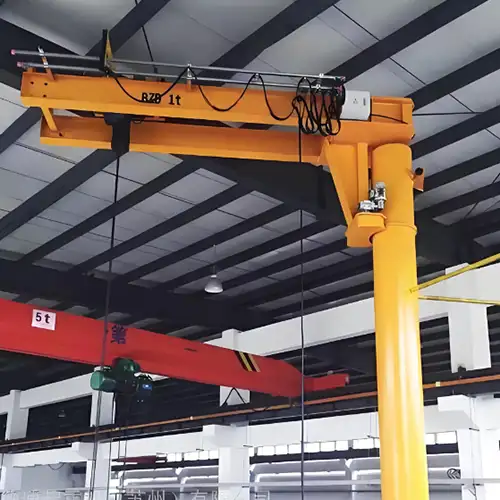
low headroom jib crane design with double beam cantilever design
Key Aspects of Customizable Load Capacities
- Wide Range of Options
Pillar-mounted jib cranes come in various load capacities, typically ranging from lightweight options for small components to heavy-duty models capable of lifting substantial materials. This broad selection enables businesses to choose the right crane for their specific applications, ensuring optimal performance in their operations. - Tailored Specifications
The ability to customize the crane's specifications means that facilities can adapt their lifting equipment to handle the precise loads they encounter daily. Whether lifting delicate electronic components or heavy machinery parts, operators can select cranes designed to meet these specific requirements. This tailored approach is crucial for maximizing efficiency and safety during lifting operations. - Enhanced Safety Features
By using cranes that are appropriately sized for their intended loads, facilities can enhance safety in the workplace. Customizable load capacities ensure that operators do not exceed the crane's limits, reducing the risk of accidents or equipment failure. When operators can rely on the correct specifications, they can focus on their tasks with greater confidence and security.
Benefits of Customizable Load Capacities in Limited Headroom Environments
- Improved Operational Efficiency
Customizing load capacities allows for optimized performance, as cranes can be matched to specific tasks. This alignment enhances productivity, as operators can lift and move loads more efficiently, minimizing downtime and maximizing output. - Flexibility in Operations
The ability to customize load capacities provides facilities with greater flexibility in their operations. As production demands change or new materials are introduced, businesses can adjust their lifting solutions without needing to invest in entirely new equipment. - Cost-Effective Solutions
Choosing cranes with the right load capacities helps businesses avoid the costs associated with over-engineering. Facilities do not need to purchase larger, more expensive cranes if their operational needs can be met with smaller, customized models. This cost-effectiveness is especially advantageous for companies operating within budget constraints. - Compliance with Safety Standards
By selecting cranes with load capacities that align with industry safety standards, facilities can ensure compliance with regulations governing material handling. This adherence to safety standards is essential for reducing risks and maintaining a safe working environment. - Increased Longevity of Equipment
Using pillar-mounted jib cranes that are properly matched to their lifting tasks contributes to the longevity of the equipment. By avoiding overloading, businesses can reduce wear and tear on their cranes, leading to lower maintenance costs and extended service life.
Pillar-mounted jib cranes offer customizable load capacities that empower facilities to select the right models for their specific operational needs. This flexibility is essential for enhancing safety and efficiency in limited headroom environments. By tailoring cranes to match the loads they handle, businesses can improve operational performance, ensure compliance with safety regulations, and achieve cost-effective solutions that contribute to long-term success.
Improved Employee Workflow and Ergonomics
The implementation of pillar-mounted jib cranes not only optimizes space but also improves employee workflow and ergonomics. By enabling workers to lift and move materials easily, these cranes reduce the physical strain associated with manual handling. This ergonomic advantage can lead to increased productivity, as employees can focus on their tasks without the fatigue that often accompanies heavy lifting.
In industrial settings, the well-being of employees is a top priority. The implementation of pillar-mounted jib cranes significantly enhances both workflow efficiency and ergonomics. By streamlining material handling processes and reducing the physical demands on workers, these cranes contribute to a healthier, more productive work environment.
Key Aspects of Improved Employee Workflow and Ergonomics
- Ease of Material Handling
Pillar-mounted jib cranes facilitate the lifting and moving of materials with minimal effort. By enabling workers to operate these cranes with ease, the physical strain associated with manual handling is greatly reduced. This ease of use empowers employees to perform their tasks more effectively and efficiently. - Reduction of Physical Strain
Manual lifting of heavy items can lead to fatigue and potential injuries over time. By providing an efficient lifting solution, pillar-mounted jib cranes minimize the physical demands placed on employees. This reduction in strain not only enhances comfort but also helps prevent work-related injuries, fostering a safer workplace. - Enhanced Focus on Tasks
With the physical demands of lifting reduced, employees can concentrate better on their specific tasks. This increased focus contributes to higher-quality work, as workers are less likely to be distracted by discomfort or fatigue. Improved concentration can lead to enhanced productivity and efficiency across operations. - Streamlined Workflow Processes
The implementation of pillar-mounted jib cranes allows for a more organized workflow. Employees can quickly lift and transport materials directly to where they are needed, reducing unnecessary movements and delays. This streamlined process enhances overall operational efficiency, as tasks can be completed faster and with less effort.
Benefits of Improved Employee Workflow and Ergonomics
- Increased Productivity
By optimizing workflow and reducing physical strain, pillar-mounted jib cranes contribute to increased productivity. Employees can complete tasks more rapidly and efficiently, leading to higher output levels and overall performance improvement. - Enhanced Employee Satisfaction
A focus on ergonomics and employee comfort can significantly boost job satisfaction. Workers who experience less physical strain and fatigue are likely to feel more positive about their work environment, leading to higher morale and retention rates. - Reduced Absenteeism
By decreasing the risk of injuries related to manual lifting, pillar-mounted jib cranes can help lower absenteeism rates. Fewer injuries mean less downtime for employees, which in turn helps maintain productivity and reduces the costs associated with training replacements or managing worker's compensation claims. - Safer Work Environment
Improved ergonomics contribute to a safer workplace. When employees are not fatigued from manual lifting, the likelihood of accidents and injuries decreases. A safer work environment promotes a culture of safety, which can further enhance employee well-being and operational efficiency. - Sustainability of Operations
By focusing on employee ergonomics, businesses can create sustainable operations that prioritize worker health and productivity. This sustainability can contribute to a positive company reputation, attracting talent and clients who value a safe and supportive work environment.
The implementation of pillar-mounted jib cranes plays a crucial role in improving employee workflow and ergonomics in industrial settings. By enabling easy lifting and movement of materials, these cranes reduce physical strain, enhance productivity, and foster a safer work environment. As a result, businesses can achieve operational efficiency while prioritizing the well-being of their employees, leading to long-term success and sustainability.
Pillar-mounted jib cranes present a versatile and efficient solution for facilities facing limited headroom and spatial constraints. Their compact design, maximized lifting height, and 360-degree operational capabilities make them ideal for optimizing space and improving workflow efficiency. By integrating these cranes into their operations, businesses can enhance productivity, ensure safety, and create a more effective work environment, all while making the most of their available space.
Benefits of Pillar Mounted Jib Cranes for Space Optimization
Space Efficiency
Compact Design and Footprint
Pillar mounted jib cranes are specifically engineered to maximize space utilization within small business environments. Their compact design minimizes the physical footprint required for operation, allowing businesses to dedicate more floor space to production and storage. Unlike larger cranes, which may require significant overhead space, these jib cranes can be installed in areas with limited vertical clearance. This feature enables businesses to efficiently organize workstations and materials without sacrificing essential operational space.
Integration into Various Work Environments
One of the standout advantages of pillar mounted jib cranes is their ability to integrate seamlessly into different work environments. They can be installed in factories, warehouses, workshops, and even outdoor settings. Because they don't rely on extensive infrastructure, these cranes can be positioned strategically to optimize workflow, regardless of the layout. Whether placed in corners to save space or near workstations for quick access, their flexibility in installation makes them suitable for a wide range of applications and settings.
Versatility
Applications in Different Industries (Manufacturing, Warehousing, etc.)
Pillar mounted jib cranes are incredibly versatile, making them ideal for various industries. In manufacturing, they facilitate the movement of heavy components, tools, and materials along assembly lines. In warehousing, they can help in organizing inventory by lifting items to shelves or moving goods to packing areas. Additionally, they are beneficial in automotive shops, construction sites, and retail environments, where the need for lifting and transporting different materials is essential. This versatility allows businesses to adapt the use of jib cranes to meet changing operational demands efficiently.
Ability to Handle Various Loads and Materials
These cranes are designed to handle a wide range of loads, from lightweight materials to heavier components. Depending on the selected capacity, pillar mounted jib cranes can efficiently lift and move various materials, including metal parts, machinery, tools, and packaged goods. This adaptability not only streamlines operations but also reduces the need for multiple lifting devices, saving costs and space in the process.
Improved Workflow
Streamlining Operations and Reducing Downtime
By implementing pillar mounted jib cranes, businesses can significantly streamline their operations. The ability to lift and move materials quickly reduces the time spent on manual handling and transportation. This efficiency minimizes downtime and ensures that production processes run smoothly, contributing to overall operational effectiveness. With less time wasted on moving items, employees can focus on more critical tasks, further enhancing productivity.
Enhancing Worker Productivity and Safety
Safety is a top priority in any work environment, and pillar mounted jib cranes contribute positively to this aspect. By reducing the need for manual lifting, they lower the risk of workplace injuries, such as strains or accidents associated with heavy lifting. Additionally, with streamlined operations, workers can perform their tasks more efficiently, leading to increased overall productivity. The enhanced safety features and ease of operation associated with these cranes create a better working environment, ultimately benefiting both employees and the business as a whole.
Applications and Case Studies
Successful Installations
Manufacturing Facilities
Pillar mounted jib cranes have been successfully installed in various manufacturing facilities to improve material handling and enhance productivity. For instance, a small-scale metal fabrication shop incorporated a 3-ton pillar jib crane into their production line. This installation allowed workers to efficiently lift and position heavy metal sheets and components for assembly, significantly reducing the manual labor involved. By integrating the crane near their welding stations, the facility saw an immediate improvement in workflow, as operators could now access materials quickly without having to navigate around large machinery. The streamlined processes led to faster turnaround times for projects and increased overall production capacity.
Automotive Shops
In automotive repair shops, pillar mounted jib cranes play a crucial role in handling heavy parts and tools safely and effectively. A local auto body shop implemented a 2-ton jib crane to assist with lifting engines and other large components during repairs. The crane's 360-degree rotation allowed mechanics to position loads precisely where they needed them, reducing the time spent maneuvering heavy parts. As a result, the shop reported a noticeable decrease in the time taken to complete repairs, enhancing customer satisfaction and increasing the number of vehicles serviced each week.
Warehouses and Distribution Centers
Warehouses and distribution centers have also benefited from installing pillar mounted jib cranes. For example, a regional distribution center for consumer goods installed a 5-ton pillar jib crane in their shipping area. The crane facilitated the lifting and moving of heavy pallets and boxes, allowing staff to efficiently load and unload shipments. The integration of the crane enabled the center to optimize its space, creating a more organized and safer environment for workers. As a result, the center experienced a reduction in order processing time, which translated into faster shipping and improved customer service.
Impact on Space Utilization and Efficiency
Measurable Outcomes (e.g., Reduced Handling Times, Increased Output)
The measurable impact of pillar mounted jib cranes on space utilization and efficiency is evident in several case studies. In the metal fabrication shop mentioned earlier, the introduction of the jib crane led to a 30% reduction in material handling times, allowing workers to complete tasks more quickly. Similarly, the auto body shop reported a 25% increase in the number of vehicles serviced weekly, attributed to the ease of lifting and positioning heavy parts. In the distribution center, the implementation of the jib crane resulted in a 20% improvement in order fulfillment rates, showcasing how effective lifting solutions can enhance operational efficiency and space utilization.
Testimonials from Business Owners
Business owners have shared positive feedback regarding the implementation of pillar mounted jib cranes in their operations. The owner of the metal fabrication shop noted, "The jib crane has transformed how we work. It's not just about lifting; it's about how we can now organize our space more effectively. Our team feels safer, and we get more done every day." Similarly, the manager of the auto body shop remarked, "Having a jib crane has made a huge difference. We no longer struggle with heavy parts, and our repair times have decreased significantly." These testimonials highlight the substantial benefits that pillar mounted jib cranes bring to small businesses, reinforcing their value in enhancing space utilization and operational efficiency.
Installation and Maintenance Considerations
Installation Process
Site Assessment and Planning
Before installing a pillar mounted jib crane, a thorough site assessment is crucial. This process involves evaluating the designated area for installation, considering factors such as ceiling height, available space, and the overall layout of the work environment. Assessing the floor's load-bearing capacity is also vital to ensure it can support the crane's weight and any loads it will handle. Planning should also take into account the crane's reach and rotation, determining the best location for optimal functionality and workflow efficiency. Additionally, any potential obstacles, such as overhead fixtures or equipment, should be identified to ensure a clear installation process.
Key Steps in the Installation Procedure
Once planning is complete, the installation process can begin. Here are the key steps involved:
- Preparation of the Installation Area: Clear the designated space of any debris or equipment to ensure a safe working environment. Mark the precise location for the base of the pillar crane.
- Securing the Base: The base of the pillar crane must be securely anchored to the floor to ensure stability during operation. Use appropriate anchors and follow the manufacturer's guidelines for installation.
- Assembling the Jib and Hoist System: Once the base is secured, the jib arm and hoist system can be assembled. This typically involves attaching the jib arm to the pillar and securing it with bolts or other fastening mechanisms.
- Testing Functionality: After assembly, it's essential to test the crane's functionality. Check the movement of the jib arm, the operation of the hoist, and ensure everything is functioning correctly. This step ensures that the crane is ready for safe operation.
Maintenance Best Practices
Regular Inspections and Servicing
Maintaining a pillar mounted jib crane is essential for ensuring safety and efficiency. Regular inspections should be conducted to check for any signs of wear and tear, including the condition of the hoist, cable, and pivot points. It is recommended to follow a routine maintenance schedule, including cleaning and lubricating moving parts, checking the integrity of the crane structure, and ensuring that all safety features are operational. Keeping a log of inspections and any maintenance performed helps in tracking the crane's condition over time and identifying any potential issues before they become serious.
Importance of Operator Training for Safety
Proper operator training is crucial for the safe and efficient use of pillar mounted jib cranes. Operators should be educated on the crane's features, operational guidelines, and safety protocols. Training programs should include hands-on practice, ensuring that operators are comfortable with the crane's operation and understand how to identify and respond to potential hazards. Emphasizing the importance of following safety guidelines can help prevent accidents and injuries, promoting a culture of safety within the workplace. Additionally, refresher courses and ongoing training can keep operators updated on best practices and any changes in regulations or equipment technology.
Conclusion
Pillar mounted jib cranes offer a multitude of advantages for small businesses, particularly in enhancing space utilization and operational efficiency. Their compact design allows for seamless integration into various work environments, maximizing available space while ensuring easy access to heavy materials. With versatile capacity options, ranging from 2 tons to 5 tons, these cranes cater to diverse lifting needs across different industries. Additionally, their ability to streamline operations and improve workflow significantly contributes to increased productivity, making them an invaluable asset for small business owners.
Given the numerous benefits that pillar mounted jib cranes provide, small business owners are encouraged to consider investing in these lifting solutions. The upfront investment is often outweighed by the long-term gains in productivity and efficiency. With the potential to reduce handling times and improve safety, a jib crane can transform how a small business operates, ultimately leading to greater profitability. By enhancing material handling processes, businesses can position themselves for growth and increased competitiveness in their respective markets.
In today's fast-paced business environment, optimizing space and enhancing operational efficiency are essential for success. Pillar mounted jib cranes represent a practical and effective solution for small businesses seeking to make the most of their available space. By providing a reliable means of lifting and moving heavy loads, these cranes contribute to a more organized and efficient workspace. Investing in a pillar mounted jib crane not only facilitates better space utilization but also empowers employees to work safely and effectively, ultimately driving the business forward. Embracing this innovative solution can lead to significant improvements in overall operational performance and contribute to a thriving business environment.
Related Products

Latest project
150 Ton Overhead Crane Installation Feedback – Paraguay Case
QDX 150 ton overhead crane in action in Paraguay. Installation photos, video, and client feedback show performance, safety, and heavy-lifting efficiency.
Free consultation to Confirm Parameters & Specifications and Get
Latest Crane Price & Crane Rate.
- Types of overhead cranes : _______?
- Optional: Overhead travelling crane, goliath gantry crane,Slewing jib crane, Single girder or double girder crane,small portable crane or kbk crane, etc.
- Capacity of overhead crane: _______?
- Optional: 0.25ton, 0.5 ton, 1 ton, 2 ton, 3ton, 5 ton, 10 ton,15ton, 20ton, 25 ton, 30ton,35ton, up to 550ton, etc.
- Crane span & lifting height : _______?
- Crane travelling length : _____?
- Control of overhead crane:_______?
- Optional: pendant/ remote/cabin control
- Voltage supply of overhead crane:_____?
- Eg,: 380V50/60HZ,3Phase or others,etc.
- Application/usage of crane:_______?
- Eg,: Steel mill, ,injection mold, cement,stone, concrete,granite, general manufacturing, etc.
Just leave a message via the contact form and our hoist and crane engineer will contact you with in 24working hours.
Get In Touch
